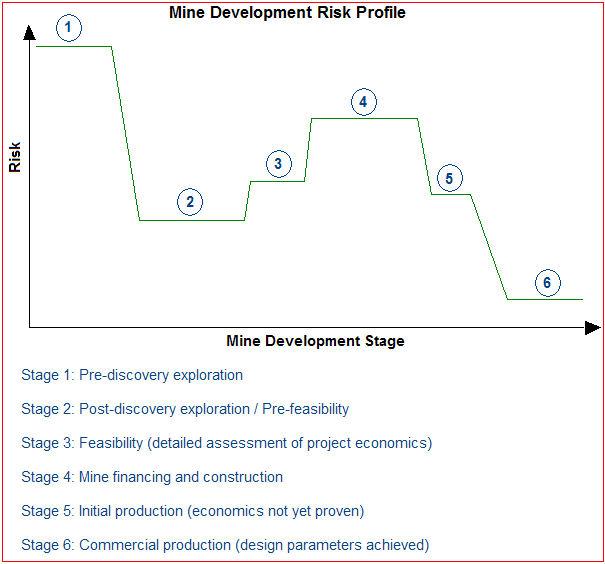Mine Development Risk Profile There are several stages in the development of a gold or silver mine --
from the exploration that leads to the initial discovery of a mineral
deposit through to commercial production. (The same, of course, applies
to the development of any other type of mine, but our focus is on gold
and silver.) Furthermore, each stage has its own risks and
opportunities.
Displayed below is a chart titled "Mine Development Risk Profile"
(MDRP) that shows how we view the mine development process. Our MDRP
breaks the process down into 6 stages, with each stage allocated a
certain investment risk level relative to other stages. Each stage's
relative investment risk is based on our assessment of the potential
for good news versus the potential for negative surprises.

Additional explanation of each stage's risk level is warranted, so here we go:
1. Pre-discovery exploration (Stage 1) is by far the riskiest stage. A
very small percentage of companies that go looking for gold (or silver)
end up finding a valuable deposit, so the probability of failure is
orders of magnitude greater than the probability of success. When
success does occur the rewards tend to be spectacular, but we prefer
situations where we can quantify value. We will occasionally take
a small position in a Stage 1 company in our own account, but will
never include such companies in the TSI Stocks List.
2. Post-discovery exploration / pre-feasibility (Stage 2) is what we
think of as the 'sweet spot'. In this stage the company has proven that
it has an attractive deposit on its hands; it's just a question of how
big. Companies that are in Stage 2 tend to issue drilling results on a
regular basis and each set of results tends to be good. At the same
time there is minimal scope for negative surprises such as cost
increases and delays.
3. The risk ramps up a little in Stage 3 because the detailed
assessment of project economics increases the potential for bad news,
particularly with regard to the amount of money the company will need
to build a mine. Also, this is the stage where various permits are
obtained, opening the door to government- and NGO-related interference.
Good news on the drilling front will generally become less frequent and
less important during Stage 3, although once a junior mining company
has completed a positive Feasibility Study and obtained the necessary
construction permits the probability of a takeover bid will rise.
4. Once a company goes into the mine construction phase (Stage 4) there
is little scope for good news and considerable scope for bad news in
the form of delays and cost overruns. Therefore, all things being equal
we would avoid Stage 4 companies, but all things are never equal and
Stage 4 stocks sometimes offer excellent risk/reward ratios due to
shareholders losing interest or over-reacting to negative surprises.
5. It is necessary to include a stage between construction and
commercial production because the initial period of production
offers-up the potential for very disappointing news. The point is that
you never really know what a mine's operating margin will be until it
actually begins to produce, so although the risk declines at the
completion of the construction stage it remains at a relatively high
level until the design parameters are achieved.
6. Once commercial production is achieved and the mine begins to
generate positive cash flow the relative risk plunges to its lowest
level. Under normal circumstances a company should therefore receive a
substantial upward re-rating in the stock market after it moves from
Stage 5 to Stage 6.

|

